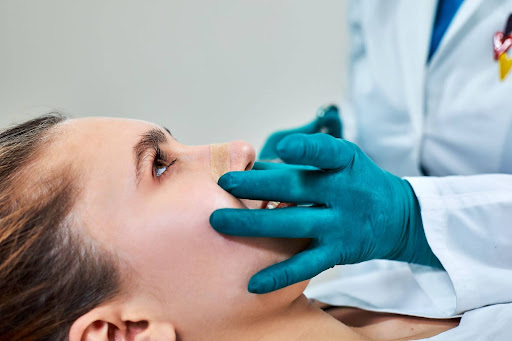Rhinoplasty, commonly referred to as a nose job, is a surgical procedure aimed at reshaping the nose to achieve aesthetic or functional goals. While the surgical techniques employed continue to evolve, postoperative management, including the use of nose taping, remains a crucial aspect of the recovery process. This comprehensive guide explores the role of nose taping after rhinoplasty and shares tips for optimal healing following nasal surgery.
Overview of the Rhinoplasty Healing Process
Following rhinoplasty surgery, the nasal skin undergoes a complex healing process characterized by swelling, pressure, and the formation of scar tissue. The initial days and weeks post-surgery are critical for managing these factors to ensure proper healing and the fulfillment of your aesthetic goals. Nasal taping is an integral component of postoperative care, designed to support the nasal structures, reduce swelling, and promote the resolution of edema.
Types of Nasal Tape Used After Nose Surgery
Several types of tape can be used for nasal taping, including:
- Medical-Grade Paper Tape: This is a common choice due to its hypoallergenic properties and gentle adhesion.
- Bandage-Like Tapes: These offer additional padding and support, particularly for areas of thicker skin or increased swelling.
- Bridge Tapes: Specifically designed to support the nasal bridge, these tapes provide targeted compression and stabilization.
- Counter Tapes: Applied along the edges of the nose, counter tapes help maintain the desired shape and prevent deformities.
The choice of tape depends on factors such as skin sensitivity, the chosen surgical technique, and the surgeon’s recommendations.
Talk to a head and neck surgeon practicing in facial plastic surgery
Why is Nasal Taping Important After a Nose Job?
Nasal taping involves the application of medical-grade paper tape or similar materials to the nasal skin to provide support and compression. This technique is typically initiated after the surgical splint or cast removal, which occurs within the first week following rhinoplasty. The primary goals of nasal taping include:
- Supporting the Nasal Structure: Taping helps stabilize the nasal tissues and structures, particularly in cases where surgical techniques have been employed to alter the nasal shape or size.
- Reducing Swelling: Gentle pressure exerted by the tape aids in reducing postoperative edema, thereby facilitating a smoother and more refined nasal contour.
- Promoting Healing: By minimizing movement and providing support, nasal taping encourages proper tissue healing and the gradual resolution of swelling and inflammation.
- Preventing Deformities: Taping helps prevent the development of deformities such as beak deformity or asymmetry by maintaining the desired shape of the nose during the early stages of recovery.
Do All Patients Require Nose Taping After Rhinoplasty?
Not all patients require nose taping after a rhinoplasty operation, but it is a common practice recommended by many surgeons to aid in the healing process and help shape the nose during recovery. Nose taping can reduce swelling, provide support to the nasal structures, and ensure that the skin reattaches properly to the underlying tissue.
The need for nose taping varies depending on the individual’s surgical procedure, skin type, and the surgeon’s preferences. It’s essential for patients to follow their surgeon’s specific post-operative instructions to achieve satisfactory results.
How long does swelling in the tip last after a rhinoplasty?
What Does the Nose Taping Process Involve?
Nose taping after rhinoplasty is a procedure used to aid in the recovery process and optimize the final results for rhinoplasty patients. This method involves applying medical tape to the nasal region to support the new shape of the nose and minimize swelling. The taping method typically begins a few days after surgery once the initial external nasal splints are removed.
The process starts with the careful cleaning of the nasal region to avoid any skin irritation. Then, strips of medical tape are strategically placed over the nose to provide gentle compression and support to the nasal bones and cartilage. Traditional nose taping involves covering the bridge and sides of the nose, ensuring that the tape is not too tight to avoid discomfort or impaired blood circulation.
Nose taping helps in reducing swelling and prevents the skin from shifting during the healing process, promoting better adherence of the skin to the underlying structure. It’s essential for patients to follow their surgeon’s instructions regarding the duration and specific technique of nose taping to achieve optimal outcomes without causing skin irritation or other complications.
How long is recovery from rhinoplasty?
How to Tape the Nose After Rhinoplasty
- Clean the Nose Area: Before starting, ensure the nose after rhinoplasty is clean and dry to prevent skin irritation and infection.
- Choose the Right Tape: Use medical tape that is gentle on the skin and designed for post-surgical care.
- Prepare the Tape Strips: Cut the tape into appropriate lengths for covering the nasal sidewalls, bridge, and tip.
- Start at the Bridge: Apply the first strip horizontally across the bridge of the nose for initial support.
- Tape the Nasal Sidewalls: Place strips vertically along the border of nasal sidewalls, extending from the bridge down to the tip to provide nasal compression.
- Secure the Tip: Apply a final strip over the tip to maintain the nasal profile and ensure stability.
- Use Adequate Technique: Ensure the tape is snug but not too tight to avoid restricting blood flow or causing discomfort.
- Practice Traditional Nasal Taping: Follow the traditional nasal taping method if recommended by your surgeon, focusing on consistency and even pressure.
- Consider 3D Splinting: In some cases, 3D splinting may be advised for enhanced support and shaping.
- Monitor Skin Quality: Regularly check for any signs of skin irritation or adverse reactions to the tape.
- Follow Surgeon’s Guidance: Adhere to the personalized approach recommended by your surgeon, considering factors like the type of surgical intervention and individual healing needs.
- Adhere to the Average Time Period: Continue the practice of nose taping for the average time period specified by your surgeon, usually ranging from several days to a few weeks.
- Ensure Optimal Skin Quality: Maintain the integrity of the skin by gently removing and reapplying tape as needed to keep the area clean and irritation-free.
5 Expert Tips To Improve The Rhinoplasty Recovery Process
Unlock the secrets to a smoother rhinoplasty recovery with expert tips tailored to enhance your healing journey. From postoperative care to communication with your surgeon, discover valuable insights that can optimize your recovery process and help you achieve your desired results with confidence and ease.
-
Follow Postoperative Instructions Diligently
Adhering to your surgeon’s guidelines is crucial for a smooth rhinoplasty recovery. This includes wearing any prescribed nose tape, especially in the initial days and weeks after the procedure. Follow instructions on cleaning the skin and attending follow-up appointments to ensure your nose heals as intended.
-
Prioritize Daily Care
Take care of your nose on a daily basis by keeping the surgical area clean and avoiding activities that may disrupt healing. Follow the skincare routine recommended by your surgeon and protect your nose from sun exposure to support the healing process in the months after rhinoplasty.
-
Communicate with Your Surgeon
Stay in touch with your surgeon throughout your recovery journey. If you have any concerns or questions about your progress or the rhinoplasty procedure, don’t hesitate to reach out. Regular communication ensures that your cosmetic goals are understood and addressed appropriately.
-
Be Patient and Consistent
Recovery from rhinoplasty takes time, and changes to the nose may continue to evolve for months after surgery. Stay patient and consistent with your postoperative care regimen, understanding that achieving your desired cosmetic goals may require ongoing attention and dedication.
-
Focus on Overall Wellness
Take care of your overall health to support your rhinoplasty recovery. This includes maintaining a balanced diet, staying hydrated, and getting adequate rest. A holistic approach to care after surgery can contribute to optimal healing and enhance the results of your rhinoplasty procedure.
The medical reasons behind rhinoplasty | Can rhinoplasty be covered by insurance?
Consult a Head and Neck Surgeon Practicing in Facial Plastic Surgery in Montreal
At Clinique Face MD, we offer a comprehensive range of cosmetic services tailored to address diverse aesthetic needs. From facial rejuvenation procedures to nose job surgeries, our team of skilled professionals is here to help you achieve your cosmetic goals. We provide personalized care, ensuring that you receive a customized treatment plan tailored to your unique facial anatomy and preferences.





